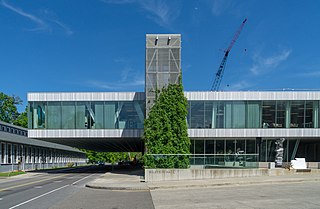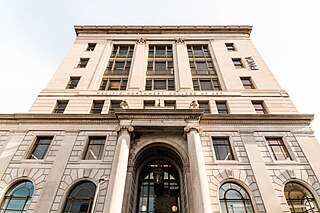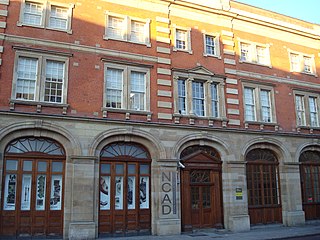
In European academic traditions, fine art is made primarily for aesthetics or creative expression, distinguishing it from decorative art or applied art, which also has to serve some practical function, such as pottery or most metalwork. In the aesthetic theories developed in the Italian Renaissance, the highest art was that which allowed the full expression and display of the artist's imagination, unrestricted by any of the practical considerations involved in, say, making and decorating a teapot. It was also considered important that making the artwork did not involve dividing the work between different individuals with specialized skills, as might be necessary with a piece of furniture, for example. Even within the fine arts, there was a hierarchy of genres based on the amount of creative imagination required, with history painting placed higher than still life.
A Bachelor of Fine Arts (BFA) is a standard undergraduate degree for students for pursuing a professional education in the visual, fine or performing arts. It is also called Bachelor of Visual Arts (BVA) in some cases.

Kendall College of Art and Design of Ferris State University (KCAD) is a college of art and design located in downtown Grand Rapids, Michigan.
The Minneapolis College of Art and Design (MCAD) is a private college specializing in the visual arts and located in Minneapolis, Minnesota. MCAD currently enrolls approximately 800 students. MCAD is one of just a few major art schools to offer a major in comic art.

An art school is an educational institution with a primary focus on the visual arts, including fine art – especially illustration, painting, photography, sculpture, and graphic design. Art schools can offer elementary, secondary, post-secondary, undergraduate or graduate programs, and can also offer a broad-based range of programs. There have been six major periods of art school curricula, and each one has had its own hand in developing modern institutions worldwide throughout all levels of education. Art schools also teach a variety of non-academic skills to many students.
The Maryland Institute College of Art (MICA) is a private art and design college in Baltimore, Maryland. Founded in 1826 as the Maryland Institute for the Promotion of the Mechanic Arts, it is regarded as one of the oldest art colleges in the United States.

The College of Architecture, Art, and Planning (AAP) is the school of architecture at Cornell University in Ithaca, New York. It offers 20 undergraduate and graduate degrees in five departments: architecture, art, urban planning, real estate, and design technology. Aside from its main campus in Ithaca, AAP offers programs in Rome, Italy and in New York City, New York.

The Pacific Northwest College of Art (PNCA) is an art school of Willamette University and is located in Portland, Oregon. Established in 1909, the art school grants Bachelor of Fine Arts degrees and graduate degrees including the Master of Fine Arts (MFA) and Master of Arts (MA) degrees. It has an enrollment of about 500 students. The college merged with Willamette University in 2021.
The Tyler School of Art and Architecture is based at Temple University, a large, urban, public research university in Philadelphia, Pennsylvania. Tyler currently enrolls about 1,350 undergraduate students and about 200 graduate students in a wide variety of academic degree programs, including architecture, art education, art history, art therapy, ceramics, city and regional planning, community arts practices, community development, facilities management, fibers and material studies, glass, graphic and interactive design, historic preservation, horticulture, landscape architecture, metals/jewelry/CAD-CAM, painting, photography, printmaking, sculpture and visual studies.
A low-residency program is a form of education, normally at the university level, which involves some amount of distance education and brief on-campus or specific-site residencies—residencies may be one weekend or several weeks. These programs are most frequently offered by colleges and universities that also teach standard full-time courses on campus. There are numerous master's degree programs in a wide range of content areas; one of the most popular limited residency degree programs is the Master of Fine Arts in creative writing. The first such program was developed by Evalyn Bates and launched in 1963 at Goddard College in Plainfield, Vermont.

The National College of Art and Design (NCAD) is Ireland's oldest art institution, offering the largest range of art and design degrees at undergraduate and postgraduate level in the country. Originating as a drawing school in 1746, many of the most important Irish artists, designers and art educators have studied or taught in the college. NCAD has always been located in central Dublin, and in 1980 it relocated to the historic Liberties area. The College has around 950 full-time students and a further 600 pursuing part-time courses, and NCAD's students come from more than forty countries. NCAD is a Recognised College of University College Dublin. It is also a member of the European League of Institutes of the Arts.

Falmouth University is a specialist public university for the creative industries based in Falmouth and Penryn, Cornwall, England. Founded as Falmouth School of Art in 1902, it was later known as Falmouth College of Art and Design and then Falmouth College of Arts until 2012, when the university college was officially granted full university status by the Privy Council.

The Yale School of Architecture (YSoA) is one of the constituent professional schools of Yale University. The School awards the degrees of Master of Architecture I, Master of Architecture II, Master of Environmental Design (M.E.D), and Ph.D in architectural history and criticism. The School also offers joint degrees with the Yale School of Management and Yale School of the Environment, as well as a course of study for undergraduates in Yale College leading to a Bachelor of Arts. Since its founding as a department in 1916, the School has produced some of the world's leading architects, including Norman Foster, Richard Rogers, Maya Lin and Eero Saarinen, among others. The current dean of the School is Deborah Berke.

The Carnegie Mellon School of Art at Carnegie Mellon University in Pittsburgh, Pennsylvania is a degree-granting institution and a division of the Carnegie Mellon College of Fine Arts. The School of Art was preceded by the School of Applied Design, founded in 1906. In 1967, the School of Art separated from the School of Design and became devoted to visual fine arts.

The College of Fine and Applied Arts (FAA) is a multi-disciplinary art school at the University of Illinois at Urbana–Champaign.

The Central Academy of Fine Arts is the only institution of higher education for fine arts under the direct charge of the Ministry of Education of China. The Manila Bulletin calls the school "China’s most prestigious and renowned art academy." It is one of the most selective universities in the country and turns away more than 95% of applicants every year. The acceptance rate was only 1.58% in 2019. Central Academy of Fine Arts is included in the Chinese state Double First-Class Construction as a Double First Class University. Central Academy of Fine Arts was the first national school of fine arts in Chinese history, and also the beginning of Chinese modern education of fine arts. Since its establishment in 1918, it has produced many notable Artists.

The Guangzhou Academy of Fine Arts is a Chinese national university based in Guangzhou which provides doctoral, master and bachelor's degrees in fine arts and design.It is the only fine arts institution of higher learning in Guangdong Province and even in South China, and one of the eight major fine arts academies in China, with 12 colleges and one affiliated secondary fine arts school, and the existing Changgang campus, University Town campus and Foshan campus, with nearly 10,000 students of all kinds.

The University of Iowa School of Art and Art History is a top 10 public art school in the US. The school is part of the University of Iowa located in Iowa City, IA which awards undergraduate and graduate degrees in art and art history. The graduate program offers Masters of Arts in art and art history, Master of Fine Arts in art, and Doctor of Philosophy in art history. One of the largest departments in the College of Liberal Arts and Sciences, the school has approximately 650 undergraduate majors, 100 graduate students and 40 faculty and is consistently ranked as one of the top ten public art schools in the US. Faculty and students have included: Grant Wood, Mauricio Lasansky, David Hockney, Elizabeth Catlett, H. W. Janson, Philip Guston, Charles Ray, and Ana Mendieta.
NIU College of Visual and Performing Arts is composed of three schools. The college also administers several university programs including, the NIU Art Museum, the NIU Community School of Arts, and NIU Huskie Marching Band.

Robert James Reed Jr. born in Charlottesville, Virginia, was an American artist and professor of painting and printmaking at Yale School of Art for 45 years. In 1987, Reed was appointed to Yale School of Art's tenured permanent faculty making him, at the time of his death, the School's first and only African-American to be so appointed in the School's then 145 year history. In his artwork, Reed is known for his geometric abstraction and personalized symbols to create a language of abstraction. He employs abstract symbols, color and deeply textured brushwork to create his iconic imagery. As Reed would explain, fragments, paths, cultural and universal signs and symbols, remembered childhood images and places are organized into his imagery. His abstractions are referential and have their basis in "real" form that exists solidly in the real world in real space. His work includes paintings, drawings, monotypes, prints and collages.


















